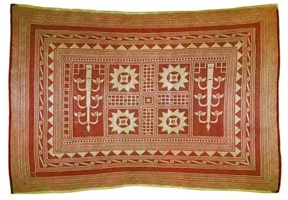Pati
Pati is a traditional appliance of house decoration and furniture. Coarse pati (mat) is generally made of cane, bamboo and straw. An improved pati is made of cane. Moreover, one kind of pati is made of leaves of date tree. The wide and substandard pati is called 'Fat mat' and thin layered pati is called 'Shital pati'. A great deal of Shital Pati is made in sylhet, noakhali and mymensingh area.

The plants used to be made of pati called 'Maratha'. Locally these are called by Murta Bet, Modabet (Cane for seat), Pati bet (Cane for mat). This tree is produced in plenty in Sylhet, Mymensingh, Patuakhali, Noakhali and Tangail. It is nicely grown in low and damp land. The tree is filled in flowers during June-July and when the trunk is matured in September, is cut down when the tree remains green. After cut, those are swamped in the water completely or partially hanging with branches and leaves hanging with Vela (Special kind of boat made with banana trunk) for a certain period of time, later those are specially processed for making ordinary mat, Jainamaj (Mat for Muslim prayer), wall-mat etc. At times, patis are adorned with the pictures of flower, mosque, play-ground, animal or bird etc. patis or mats are given name in accordance with the pictures inserted viz. game house, Asman Tara (Star of the sky), Jamin Tara (Star of the world), Taj Mahal etc. Besides ordinary mats, the mat-makers also manufacture wall mat, hand mat, side bag, moneybag, tablemat etc. Some mats are adorned with silver plate or tusk. The mat having length 6 feet x 9 feet, ornamented with such precise materials, may cost 5 to 50 thousand taka and takes two to two and half years to complete.
Although matmakers are seen living plenty in some area, they are, in general, scattered all over the country. Rajnagar, Balagonj, Borolekha, Molla-Bazar of Sylhet, Sonagazi and Rampur of Barisal, Sarupkhat of Potuakhali, Salair of Faridpur,' Jain pur of Mohongonj of etc. are famous for mats. About ten thousand mat makers are scattered around Bangladesh. They are inherently carried out their jobs from generation to generation. Most of the mat-makers of Sylhet are women. As a result a woman having knowledge to weave a pati is of great demand in the marriage market. They belonged to both the Muslim and Hindu community. The Hindu matmakers are almost belonged to Vaishvava faith. On the other hand, Muslims belonged to various communities. [Gofran Faroqi]
